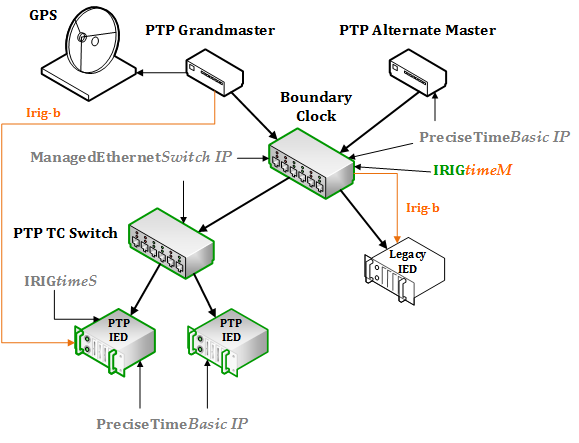Inter-range instrumentation group timecodes, commonly known as IRIG timecode, are standard formats for transferring timing information.
The term IRIG signals is used to refer to a whole group of serial timecodes, which use a continuous stream of binary data to transmit information on date and time. The individual time code formats can be distinguished by the signal characteristics, e.g. modulated versus unmodulated, which require different ways of signal transmission, by the data rate, and by the kind of information included in the transmitted data.
Back in 1956 the TeleCommunication Working Group (TCWG) of the American Inter Range Instrumentation Group (IRIG) was mandated to standardize different time code formats, resulting in IRIG Document 104-60. The latest revision is IRIG Standard 200-04 which is the current version specifying some new codes which also transmit a year number. IRIGB is widely used to synchronize systems in Substation Automation Systems (SAS) and in Defence and Aerospace. Nowadays, it is quite frequent combining IEEE 1588v2 systems with IRIG-B systems.

IRIG SERIAL TIME CODE FORMATS 200-04 (Range Commanders Council)
IRIG-B standard de fines several modulation types, carrier frequencies and coded expressions. The user must be con figure the expected IRIG-B time code in order to ensure the synchronization with the master or the slave.
IRIG-B Modulation types
When it comes to modulation tiypes, IRIG-B defines three different modulations:
- Direct Current Level Shift (DCLS): Different pulse widths represent coded data. This is the most common modulation methos used today due to its high accuracy.
- Amplitude Modulated (AM): Modulated with a 1kHz sine wave carrier signal, this signal has no DC content. It is not the choice because of its low signal accuracy.
- Modified Manchester Modulation: This is the least used modulation type for IRIG-B. Modified Manchester modulation uses a 1kHz square wave with phase modulation rather than DC level shift. It allows transmissions over long distances while maintaining a high accuracy.
Carrier frequency
Regarding the carrier frequency, this will depend on the modulation type. As an example, as with DCLS modulation there is no carrier wave form, there would be no carrier frequency. Having said this, only the AM and the Modified Manchester modulations use a carrier wave form, and commonly using a 1kHz carrier.
These would be the common IRIG-B formats:
- IRIG-B00z: This is for DCLS IRIG-B signal with no carrier.
- IRIG-B12z: This is for AM signal with a 1kHz carrier sine wave.
- IRIG-B22z: This is for modified Manchester modulation type with a 1kHz square wave carrier.
SoC-e provides technology to integrate IRIG-B protocol. Either if you are planning to implement an IRIG-B Slave or Master (or even both), the following products shall be of your interest: IRIG-B Master IP Core and IRIG-B Slave IP Core. In addition, MultiSync IP Core solution is also available, which provides time reference redundancy over IRIG-B as well as PTP, as well as operating as a bridge between IRIG-B and PTP protocols.
